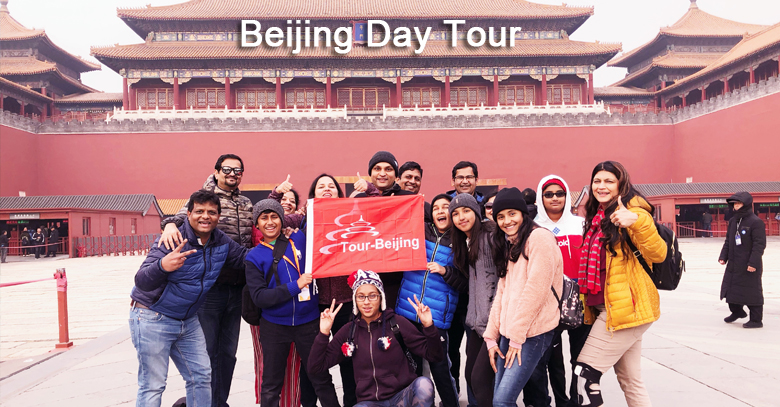What North Korean propaganda posters reveal
朝鲜的宣传海报揭示了什么
CNN 奥斯卡·霍兰德报道 Written by Oscar Holland, CNN

To the outside world, North Korean propaganda posters are notorious for their militaristic and anti-American messages. Recent topics include Donald Trump being attacked with an axe and missiles pointing at Capitol Hill.
But one former Pyongyang resident is hoping that her sizable Korean poster collection can present a more nuanced picture of art in the reclusive state. Stanford fellow Katharina Zellweger -- who lived in Pyongyang for five years while working for a Swiss government agency -- has collected over 100 examples from inside the country.
在外界看来,朝鲜的宣传海报因其“军国主义”和反美信息而臭名昭著。最近的海报的主题包括唐纳德·特朗普(Donald Trump)遭斧头攻击及国会山被导弹锁定。但斯坦福大学(Stanford)研究员凯瑟琳娜•齐薇格(Katharina Zellweger)曾在一家驻平壤的瑞士政府机构工作,她在那里生活了五年。作为一名前平壤居民,她希望她收藏的大量朝鲜海报 能展现出这个封闭国家更微妙的艺术风貌。她从朝鲜内部收集了超过100个样本。

1/20 – "Let us achieve the party's agriculture revolution policy thoroughly and brighten the year with increased grain production."
Stanford fellow Katharina Zellweger -- who lived in Pyongyang while working for a Swiss government agency -- has collected over 100 posters from North Korea.
1/20——让我们把党的农业革命政策落到实处,以粮食增产给新的一年增添新的光彩。
斯坦福大学研究员凯瑟琳娜·齐薇格(Katharina Zellweger)为一家瑞士政府机构工作期间住在平壤,她已经从朝鲜收集了100多张海报。
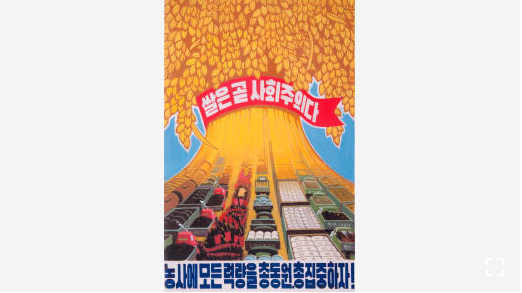
3/20 – "Rice is socialism. Let us concentrate all efforts on agriculture!"
The posters often reflect the priorities of the North Korean government, encouraging citizens to rally around a certain cause. Credit: University Museum and Art Gallery, The
3/20 -“大米是社会主义。让我们把全部精力集中在农业上!”
这些海报往往反映了朝鲜政府的优先事项,鼓励民众为某项事业团结起来。资料来源:香港大学大学博物馆及艺术馆

4/20 – "Securing a high-yield variety is a definitive guarantee of increased grain production"
Featuring a microscope and a selection of foodstuffs, this poster shows "changes in crops and practices becoming more efficient," according the director of the University Museum.
4/20 -“高产品种是粮食增产的绝对保证”
大学博物馆馆长说,这幅海报以显微镜和精选的食物为特色,展示了“改良作物及科学种植的有效性”
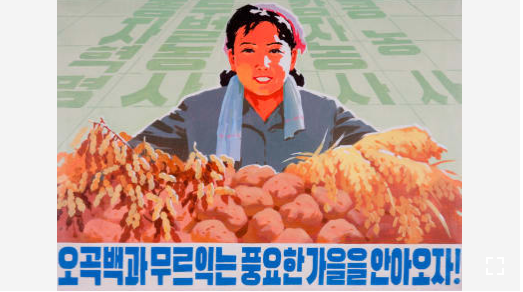
5/20 – "Let us get a fertile autumn where many fruits and grains become ripe"
Almost all state posters in North Korea feature large worded slogans. Literacy may not be as high as the 100% figure reported by the country's officials, but Zellweger believes that
5/20 -“让我们有一个丰收的秋天,瓜果飘香和谷物成熟”。
朝鲜几乎所有的国家海报都有大字标语。那里的识字率可能没有官方报告的有100%那么高,但齐薇格相信这一点。
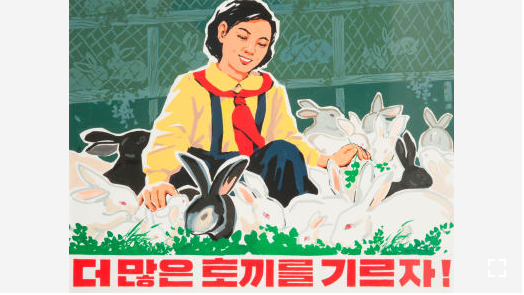
6/20 – "Let us breed more rabbits!"
"What happens is that, usually, the government announces the subject -- let's say breeding rabbits -- and then different artists paint posters," Zellweger said. "
6/20 -“让我们繁殖更多的兔子!”
齐薇格说:“通常情况下,政府会公布主题——比方说饲养兔子——然后不同的艺术家会画海报。
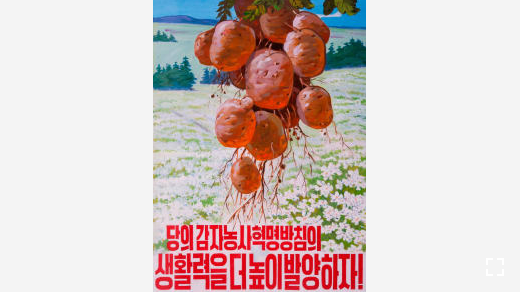
7/20 – "Let us elevate the vitality of the Party's innovation policy on potato farming!"
7/20——“让我们提升党的马铃薯种植创新政策的活力!”
The posters often celebrate and promote policies devised by the ruling Workers' Party of Korea. Credit: University Museum and Art Gallery, The University of Hong Kong
这些海报经常颂扬和宣传执政党朝鲜劳动党(Workers' Party of Korea)制定的政策。
资料来源:香港大学大学博物馆和艺术馆
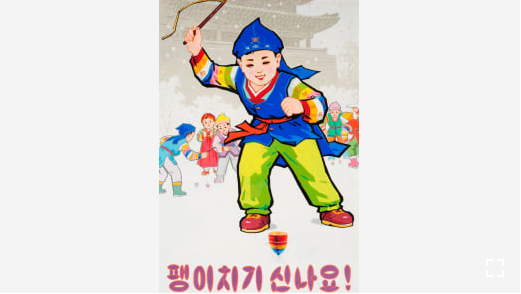
8/20 – "Spinning tops is fun!"
As well as addressing political and economic issues, the posters carry social or familial messages. This image encourages children to play with spinning tops. Credit: University
8/20 -“旋转陀螺很有趣!”
除了处理政治和经济问题,这些海报还带有社会或家庭信息。这张照片鼓励孩子们玩陀螺。资料来源:香港大学大学博物馆及艺术馆
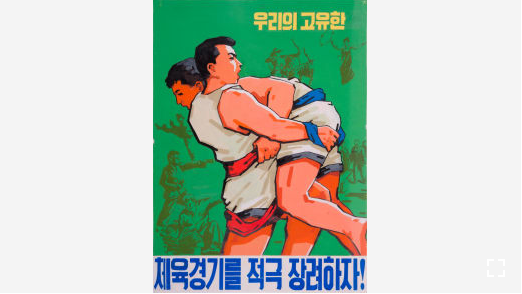
9/20 – "Let us actively encourage our own athletic games"
"(The posters) promote family values, welfare, social activities -- things very much away from what people would perceive as political propaganda," Knothe said Credit: University
9/20 -“让我们积极支持自己的运动会”
诺斯说:“这些海报宣传的是家庭价值观、福利和社会活动,而不是人们所认为的政治宣传。

10/20 – "Let us provide more electricity to the battlefields where we are breaking new ground!"
"(The posters) suggest social change, economic growth and scientific advances like the electrification of the country," said Knothe. Credit: University Museum and Art Gallery, The
10/20 “让我们为正在开辟新领域的战场提供更多的电力!”
诺斯说:“这些海报显示了社会变革、经济增长以及国家电气化等科学进步。”资料来源: 香港大学大学博物馆及艺术馆
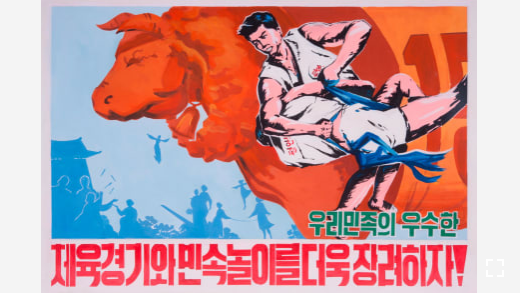
11/20 – "Let us further encourage our nation's excellent sports activities and folk games!"
Athletic achievements and international sporting events are topics commonly addressed by the propaganda posters. Credit: University Museum and Art Gallery, The University of
11/20-“让我们进一步鼓励我们国家优秀的体育活动和民间游戏!”
体育成就和国际体育赛事是宣传海报中常见的话题。资料来源: 香港大学大学博物馆及艺术馆
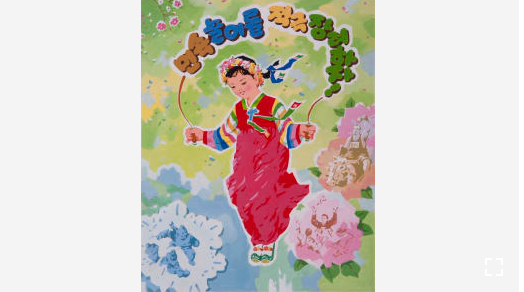
12/20 – "Let us actively encourage folk games"
"The posters often use a very clever combination of words and pictures so their messages are integrated into the image," said Knothe. Credit: University Museum and Art Gallery, The
12/20 -“让我们积极鼓励民间游戏”
诺斯说:“这些海报通常会巧妙地结合文字和图片,这样他们的信息就会融入到图像中。”资料来源: 香港大学大学博物馆及艺术馆
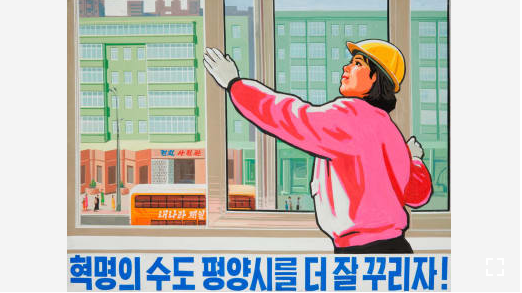
13/20 – "Let us better manage Pyongyang, the capital of innovation"
Although soldiers are normally always depicted as males, women are often used to communicate messages relating to agriculture and industry. Credit: University Museum
13/20 -“让我们更好地管理好创新之都平壤”
虽然士兵通常被描述为男性,但女性经常被用来传达与农业和工业有关的信息。资料来源: 香港大学大学博物馆及艺术馆

14/20 – "Let us plant more acacias"
Most of the posters -- including all of those in Zellweger's collection -- were painted by hand. Credit: University Museum and Art Gallery, The University of Hong Kong
14/20 -“让我们种更多的洋槐”
大多数海报——包括齐薇格所有的海报——都是手工绘制的。资料来源:香港大学大学博物馆及艺术馆

15/20 – "Let us switch grass with meat!"
Many of the posters are produced at the Mansudae Art Studio, a state-run facility believed to employ around 1,000 of the country's most gifted artists. Credit: University Museum an
15/20 -“让我们用肉换草吧!”
许多海报都是在万寿台海外开发会社的艺术工作室制作的。据信,这家国营机构雇佣了大约1000名日本最有天赋的艺术家。资料来源: 香港大学大学博物馆及艺术馆

16/20 – "Let us extensively develop double cropping!"
Propaganda posters are used to promote better practices in agriculture and industry. Credit: University Museum and Art Gallery, The University of Hong Kong
16/20——“让我们广泛发展二熟制!”
宣传海报用于促进农业和工业的更好做法。资料来源:香港大学大学博物馆及艺术馆

17/20 – "My country as the beautiful and salubrious socialist Mount Kumgang!"
This poster relates to Mount Kumgang, a scenic mountain in the east of the country. Credit: University Museum and Art Gallery, The University of Hong Kong
17/20——“我的祖国是美丽而健康的社会主义金刚山!”
这张海报与朝鲜东部的风景名山金刚山有关。资料来源:香港大学大学博物馆及艺术馆

18/20 – "More cotton!"
The message is often simple and direct, such as this poster calling for "more cotton!" Credit: University Museum and Art Gallery, The University of Hong Kong
18/20 -“更多的棉花!”
信息通常是简单而直接的,比如这张呼吁“更多棉花!”资料来源:香港大学大学博物馆及艺术馆

19/20 – "Let us raise more grass-eating animals!"
One of 25 of the posters now on display at the University Museum and Art Gallery in Hong Kong. Credit: University Museum and Art Gallery, The University of Hong Kong
19/20 -“让我们养更多食草动物!”
这是香港大学博物馆及艺术馆展出的25幅海报之一。资料来源:香港大学大学博物馆及艺术馆
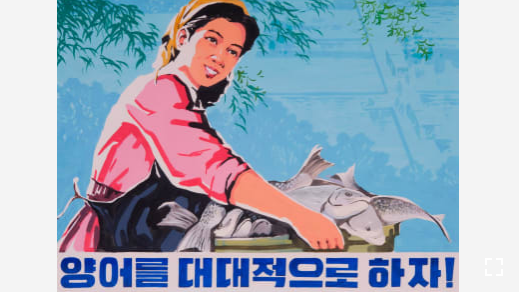
Most of the images promote agriculture and science, offering an alternative to the violent scenes typically associated with North Korean propaganda. The posters, which encourage hard work and solidarity, are reinforced with depictions of smiling model citizens and images celebrating national achievements.
大多数图片都在宣传农业和科学,提供了一种与朝鲜宣传有关的暴力场景的替代方案。这些海报鼓励努力工作和团结一致,并配有微笑的模范公民和庆祝国家成就的图片。
With 25 of the posters now on display at the University Museum and Art Gallery in Hong Kong, CNN spoke to Zellweger and the museum's director, Florian Knothe, about the design elements in posters that are often overlooked.
现在,香港大学博物馆和美术馆展出了25幅海报,CNN采访了齐薇格和博物馆馆长弗洛里安·诺特(Florian Knothe),讨论了海报中经常被忽视的设计元素。
Women feature prominently
突出女性特点

Soldiers depicted in anti-American (or anti-Japanese) posters are normally always male. But women are often used to communicate messages relating to agriculture and industry.
反美(或反日)海报上的士兵通常都是男性。但女性经常被用来传达与农业和工业有关的信息。
"Farmers are almost always smiling women promoting new agricultural policies and raising rabbits and producing more cotton," Zellweger said.
Knothe added: "You have a lot of females propagating topics that are labor or science related."
齐薇格说:“农民们几乎都是面带微笑的妇女,她们在推广新的农业政策、饲养兔子和生产更多的棉花。”
诺斯补充说:“有很多女性传播与劳动或科学相关的话题。”
They communicate essential public information
他们传达重要的公共信息
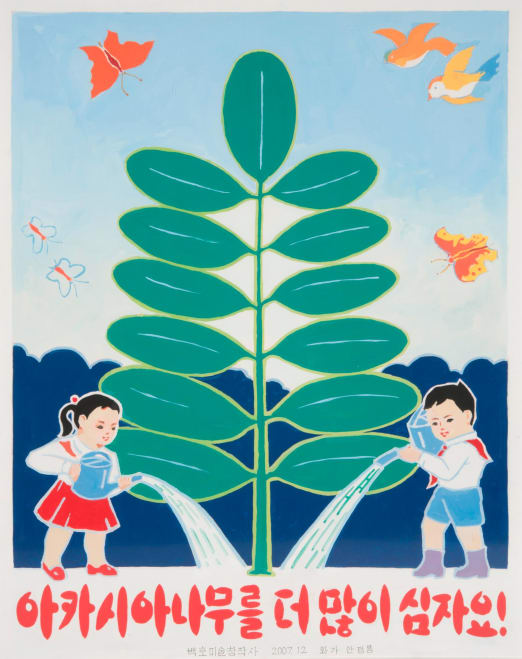
"Let us plant more acacia trees." Credit: University Museum and Art Gallery, The University of Hong Kong
让我们种更多的槐树” 资料来源:香港大学大学博物馆及艺术馆
Like anywhere in the world, North Korea's authorities use posters as a channel for disseminating public information. With restricted internet access, and just a handful of authorized television channels, it's one of the most effective ways of reaching communities around the country.
与世界上任何地方一样,朝鲜当局将海报作为传播公共信息的渠道。由于互联网接入受到限制,只有为数不多的几个授权电视频道,这是联系全国各地社区最有效的方式之一。
"There was a poster produced for national census day in 2008," Zellweger said. "Everyone knew that they had to be home in order to meet the people (carrying out) the census."
North Korea also produces a number of anti-smoking posters, having joined the WHO's Framework Convention on Tobacco Control in 2005. The WHO reports that the country "keenly celebrates" World No Tobacco Day every year.
齐薇格说:“2008年全国人口普查日有一张海报。“每个人都知道他们必须回家才能见到人口普查的工作人员。”
朝鲜在2005年加入了《世界卫生组织烟草控制框架公约》(Framework Convention on Tobacco Control),还制作了一些反吸烟海报。世界卫生组织报告说,朝鲜每年都“热烈庆祝”世界无烟日。
They document developments in the country
他们记载了这个国家的发展
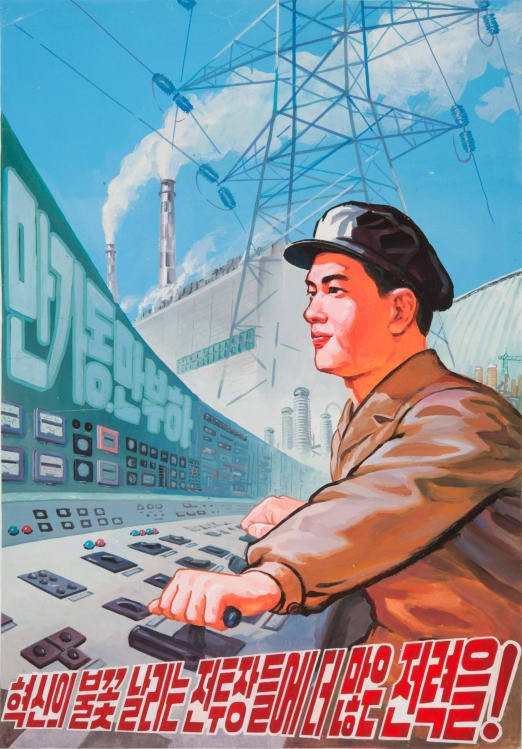
"Let us provide more electricity to the battlefields where we are breaking new ground!" Credit: University Museum and Art Gallery, The University of Hong Kong
“让我们为正在开辟新领域的战场提供更多的电力!”资料来源:香港大学大学博物馆及艺术馆
North Korean propaganda can be used to track changes within the country. Historically, posters have reflected the priorities of the country's leadership at any given moment.
朝鲜的宣传可以用来追踪国内的变化。从历史上看,海报反映了国家领导人在任何特定时刻的优先事项
"You can really see how, over time, different policies were communicated to the people," Knothe said. "They (also) suggest social change, economic growth and scientific advances -- like the electrification of the country."
“你可以看到,随着时间的推移,不同的政策是如何传达给人民的,”诺斯说。“它们(还)表明社会变革、经济增长和科学进步——比如国家电气化。”
The posters in Zellweger's collection are particularly useful for examining developments that have taken place in the agricultural sector.
"(You can see) changes in crops and practices becoming more efficient," Knothe said. "A common drive is finding ways to be more productive. There's a poster featuring a microscope and a selection of crops that reads: ''Improvement for seeking high-yield seeds for varieties guarantee a rich harvest.'
"It's a very direct and blunt message, but I think that's a good example of (the mid-2000s) policies that tried to revolutionize farming."
齐薇格收藏的海报对研究农业部门的发展特别有用。
诺斯说:“(你可以看到)作物和实践的变化变得更加有效。”“一个共同的动力是找到提高效率的方法。这里有一张海报,上面有显微镜和精选的农作物,上面写着:“高产种子多样化,保障农业大丰收。”
“这是一个非常直接和直率的信息,但我认为这是(2005年前后)试图改革农业的政策的一个很好的例子。”
Stylistically, little has changed
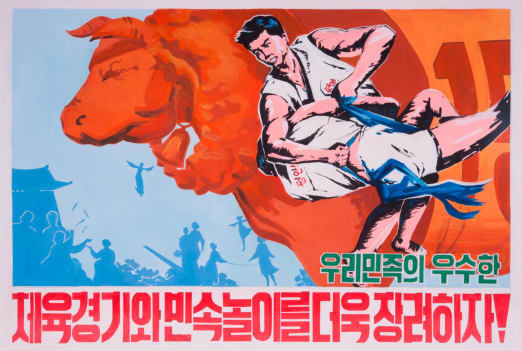
"Let us further encourage our nation's excellent sports activities and folk games!" Credit: University Museum and Art Gallery, The University of Hong Kong
“让我们进一步鼓励我们国家优秀的体育活动和民间游戏!”
资料来源:香港大学大学博物馆及艺术馆
Despite the advances depicted, the posters' style has remained remarkably consistent since the 1950s. They continue to draw heavily on the traditions of socialist realism, an artistic approach once popular throughout the communist world.
尽管有这些进步,这些海报的风格自20世纪50年代以来一直保持着没变。他们继续大量借鉴社会主义现实主义的传统,这是一种曾经风靡共产主义世界的艺术方法。
"I don't see a real development in their sophistication -- they follow their own tradition," Knothe said. "The posters in the exhibition (possess) a certain uniform look. They all differ tremendously in color and the way they talk to you, but the composition of the images is quite constant throughout time.
"What I find interesting is the way they use foreground and background -- a juxtaposition that is normally very well-defined. (In the foreground) they put a figure who addresses the people and makes that connection. And it's always a person who is communicating the message to the public."
“我看不出他们的世故有什么真正的发展——他们遵循自己的传统,”诺斯说。展览中的海报具有某种统一的外观。它们在颜色和与你交谈的方式上都有很大的不同,但是图像的组成在时间上是相当恒定的。
“我发现有趣的是他们使用前景和背景的方式——一种通常定义非常明确的并置。(前景)他们放了一个人,这个人向人们讲话,并建立了联系。而且总是一个人在向公众传达信息。”
Many are still hand-painted
许多海报仍然是手绘的
"Let us raise more grass-eating animals!" Credit: University Museum and Art Gallery, The University of Hong Kong
“让我们养更多的食草动物吧!”资料来源:香港大学大学博物馆及艺术馆
This continuity also reflects the production process, which has barely changed over the decades. Most of the posters -- including all of those in Zellweger's collection -- were painted by hand.
"What happens is that, usually, the government announces the subject -- let's say breeding rabbits -- and then different artists paint posters," Zellweger said. "Like a competition, one or two are chosen and then these are multiplied by the thousand in print."
这种连续性也反映了几十年来几乎没有变化的生产过程。大多数海报——包括齐薇格所有的海报——都是手工绘制的。
齐薇格说:“通常情况下,政府会公布主题——比方说饲养兔子——然后不同的艺术家会画海报。”“就像一场比赛,选出一两个,然后把它们成倍地印刷出来。”
Many of the works are produced at the Mansudae Art Studio, a state-run facility believed to employ around 1,000 of the country's most gifted artists. In addition to posters, the studio produces statues, paintings, ceramics and other state-supported artworks.
许多作品都是在万寿台海外开发会社艺术工作室(Mansudae Art Studio)创作的。据信,这家国营机构雇佣了约1000名日本最有天赋的艺术家。除了海报,工作室还生产雕像、绘画、陶瓷和其他国家支持的艺术品。
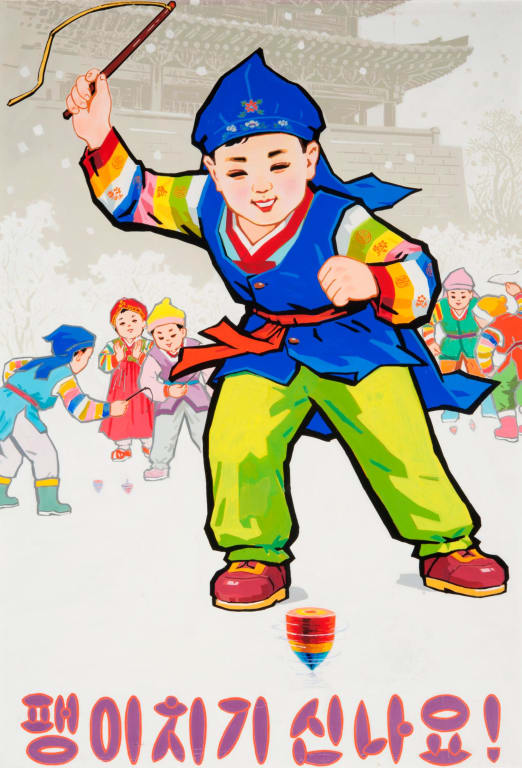
"Spinning tops is fun!" Credit: University Museum and Art Gallery, The University of Hong Kong
“旋转陀螺很有趣!” 资料来源:香港大学大学博物馆及艺术馆
Almost all propaganda posters in North Korea feature large worded slogans. Examples from Zellweger's collection include: "Let us further encourage our nation's excellent sports activities and folk games!" and "Let us raise more grass-eating animals!"
Despite widespread poverty and low life expectancy, education is both free and compulsory in North Korea. Literacy may not be as high as the 100% figure reported by the country's officials, but Zellweger believes that posters are designed on the assumption that everyone can read.
"I've never met a North Korean boy or girl -- or adult -- who cannot read, write and do the simple math," she said.
朝鲜几乎所有的宣传海报都有大字标语。齐薇格收集的例子包括:“让我们进一步鼓励我们国家优秀的体育活动和民间游戏!”和“让我们饲养更多食草动物!”
尽管普遍贫困和预期寿命较低,但在朝鲜,教育是免费和义务的。文盲率可能没有官方报道的100%高,但齐薇格认为海报的设计是基于人人都能阅读的假设。
她说:“我从未见过一个朝鲜男孩或女孩——或成年人——不会读、写和做简单的数学运算。”
Colors matter
颜料
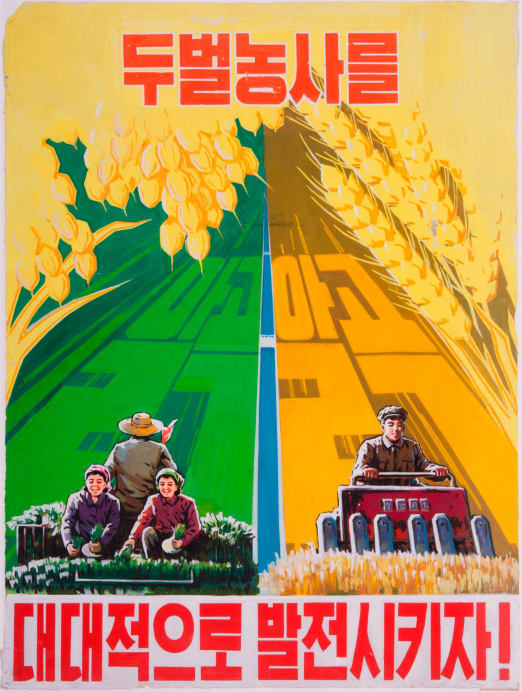
"Let us extensively develop double cropping!" Credit: University Museum and Art Gallery, The University of Hong Kong
“让我们广泛发展二熟制 ” 资料来源:香港大学大学博物馆及艺术馆
Propaganda posters typically rely on brightly colored images and text. But as well as catching the eye, colors are symbolic and have been chosen to resonate with the public.
"The traditional Korean color symbolism is based on the five elements -- wood, fire, earth, metal and water," Zellweger explained. "And most of the time, the posters use the five basic colors -- blue, red, yellow, white and black.
宣传海报通常依靠色彩鲜艳的图片和文字。但是,除了吸引眼球,颜色也是象征性的,并被选择与公众产生共鸣。
齐薇格解释说:“朝鲜传统的色彩象征是以木、火、土、金、水五种元素为基础的。”大多数情况下,海报使用的是五种基本颜色——蓝色、红色、黄色、白色和黑色。
"The colors all have meaning. Red is the color of socialism and aggression but also passion. Blue means peace and harmony, though it also symbolizes integrity and is often used on educational posters. Black represents darkness and evil, so is often used in anti-American and anti-Japanese posters. Gold and yellow is for prosperity and glory."
“所有的颜色都有意义。红色是社会主义和侵略的颜色,也是激情的颜色。蓝色意味着和平与和谐,但它也象征着正直,经常用于教育海报。黑色代表黑暗和邪恶,所以经常出现在反美和反日海报中。黄金和黄色代表繁荣和荣耀。”
"Korea's Public Face: Twentieth-century Propaganda Posters from the Zellweger Collection" is on at The University Museum and Art Gallery (UMAG) at the University of Hong Kong until Jan. 28, 2018.
“朝鲜的公众形象:20世纪宣传海报——齐薇格藏品展”将于2018年1月28日在香港大学的大学博物馆和艺术画廊(UMAG)展出。
TB北京中文旅游服务
北京外宾旅游
北京外宾特色旅游
北京外宾旅行指南
北京包车旅游
北京参团旅游
北京长城徒步游
北京租车服务
北京定制旅游
TB北京英文旅游服务
Beijing Tour
Great Wall Tour
Beijing Tour Packages
Beijing Day Tour
Beijing Group Tour
Beijing Winter Tour
Car Rental in Beijing
Create My Beijing Trip
TB 英语
环球旅游英语
健康生活英语
新闻英语词汇
生活英语词汇
英语文学词汇
英语咬文嚼字
英汉智慧语录
版权声明:本文为原创文章,版权归 admin 所有,欢迎分享本文,转载请保留出处!


